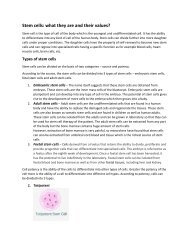Stem cells: what they are and their values?
These stem cells can treat diseases by regenerating themselves into daughter stem cells which further replace the damaged cells of the body to repair the tissues and organs.
These stem cells can treat diseases by regenerating themselves into daughter stem cells which further replace the damaged cells of the body to repair the tissues and organs.
You also want an ePaper? Increase the reach of your titles
YUMPU automatically turns print PDFs into web optimized ePapers that Google loves.
Cord blood<br />
Cord blood (umbilical cord blood) is blood that remains in the placenta <strong>and</strong> in the attached umbilical<br />
cord after childbirth.<br />
Cord blood is made up of these components - Red blood <strong>cells</strong>, Blood, Plasma, platelets, which <strong>are</strong> found<br />
in the whole blood. In comparison with the whole blood, there <strong>are</strong> some differences in the cord blood,<br />
such as the cord blood contains more natural killer <strong>cells</strong>, lower absolute numbers of the T-<strong>cells</strong> <strong>and</strong> a<br />
higher immature T-<strong>cells</strong> <strong>are</strong> available. However, it is mainly the observation that cord blood contains<br />
various types of stem <strong>and</strong> progenitor <strong>cells</strong>, mostly hematopoietic stem <strong>cells</strong>, that contributes to the<br />
interest of cord blood. Many non-hematopoietic stem cell types <strong>are</strong> also present in cord blood, such as<br />
Mesenchymal stem <strong>cells</strong>, but in a lesser amount than bone marrow. Cord blood can also include<br />
endothelial progenitor <strong>cells</strong> <strong>and</strong> multipotent adult stem <strong>cells</strong>. Cord blood stem <strong>cells</strong> <strong>are</strong> frequently<br />
confused with embryonic stem <strong>cells</strong>. Cord blood stem <strong>cells</strong> <strong>are</strong> the type of adult stem <strong>cells</strong> which is<br />
different from the embryonic stem <strong>cells</strong>.<br />
• Use of cord blood<br />
Cord blood is used the same way that hematopoietic stem cell transplantation is used to<br />
reconstitute bone marrow following radiation treatment for various blood cancers, <strong>and</strong> for<br />
various forms of anaemia. Its efficacy is similar as well.<br />
• Diseases treated by cord blood stem <strong>cells</strong><br />
Cord blood is rich in hematopoietic stem <strong>cells</strong> those <strong>are</strong> pluripotent that means <strong>they</strong> have the<br />
potency to regenerate themselves into any kind of cell of the body. The hematopoietic stem<br />
<strong>cells</strong> can treat diseases related to blood <strong>and</strong> immune system such as leukaemia, anemia, SCIDs,<br />
hypoplasia, etc.





